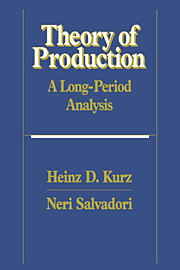Book contents
- Frontmatter
- Contents
- Preface
- A reader's guide
- 1 Free competition and long-period positions
- 2 A one-commodity model
- 3 Two-commodity models
- 4 Models with any number of commodities
- 5 Choice of technique
- 6 Alternative descriptions of a technique
- 7 Fixed capital
- 8 Joint production
- 9 Jointly utilized machines
- 10 Land
- 11 Persistent wage and profit rate differentials
- 12 On limits to the long-period method
- 13 Production as a circular flow and the concept of surplus
- 14 The neoclassical theory of distribution and the problem of capital
- 15 On some alternative theories of distribution
- Mathematical appendix
- References
- Name index
- Subject index
13 - Production as a circular flow and the concept of surplus
Published online by Cambridge University Press: 06 January 2010
- Frontmatter
- Contents
- Preface
- A reader's guide
- 1 Free competition and long-period positions
- 2 A one-commodity model
- 3 Two-commodity models
- 4 Models with any number of commodities
- 5 Choice of technique
- 6 Alternative descriptions of a technique
- 7 Fixed capital
- 8 Joint production
- 9 Jointly utilized machines
- 10 Land
- 11 Persistent wage and profit rate differentials
- 12 On limits to the long-period method
- 13 Production as a circular flow and the concept of surplus
- 14 The neoclassical theory of distribution and the problem of capital
- 15 On some alternative theories of distribution
- Mathematical appendix
- References
- Name index
- Subject index
Summary
In Chapter 1 and in the Historical Notes of the subsequent chapters an attempt was made to lay bare the origins of the concepts used in the present book and to provide a brief summary of the historical development of the ideas and arguments contained in the main text. While these notes may prove useful for a better understanding of some of the roots of the approach elaborated, they cannot, scattered and sparse as they are, replace a pointed discussion of the analytical tradition to which the present investigation belongs. This chapter is designed to make good that lacuna. The emphasis is on the conceptualization of production as a circular flow and the related concept of social surplus. In contradistinction, in Austrian and in much of neoclassical analysis, production is conceived of as a linear flow which leads from the services of the primary factors of production to final goods. The neoclassical theory of production and income distribution will be dealt with in Chapter 14.
A major concern will be with the two main intellectual sources of the present book: Piero Sraffa's Production of Commodities by Means of Commodities (1960) and John von Neumann's essay “Über ein ökonomisches Gleichungssytem und eine Verallgemeinerung des Brouwerschen Fixpunktsatzes” (1937) [“A Model of General Economic Equilibrium” (1945)], and the tradition in the history of economic thought to which these belong. As the reader will have noticed, the approach chosen in this book is essentially a “cross-breed” of the analyses of Sraffa and von Neumann.
- Type
- Chapter
- Information
- Theory of ProductionA Long-Period Analysis, pp. 379 - 426Publisher: Cambridge University PressPrint publication year: 1995



